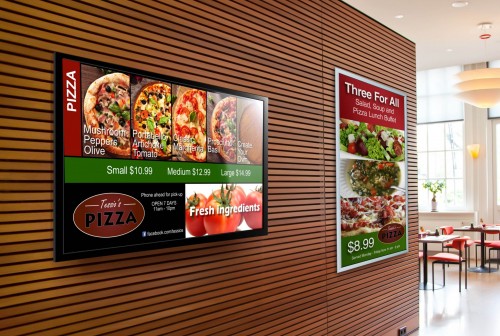Digital Signage: Strategies for sign companies
by all | 5 August 2014 1:30 pm
 [1]
[1]Images courtesy Roland DGA
By Peter Saunders
The market for digital signage is growing by all measures. In late 2013, for example, a report from analytics firm IHS predicted the global digital signage industry would increase in value—in terms of revenue for equipment, software, services and media—to $14 billion in 2014 and onward to $17.1 billion by 2017.
“Improvements in technology offerings, data management and infrastructure expansion will help the industry continue its positive momentum,” says Sanju Khatri, IHS’s director for signage and public information displays. “With ‘smart’ content and dynamic interfaces, the integration of real-time data into real-world applications will further stimulate revenue growth.”
Digital signage has had an especially major impact with retailers, who are using it to target customers more efficiently, prolong their ‘dwell’ time, improve shopping experiences and increase sales. IHS predicted the retail sector would account for 42 per cent of total digital signage display revenue for the 2013-2017 period.
 [2]
[2]Digital signage has helped retailers target customers more efficiently, prolong their ‘dwell’ time, improve shopping experiences and increase sales.
Quick-service restaurants (QSRs), too, are using digital signage to offer dynamic content and appealing visuals, particularly by replacing ‘static’ menu boards with screens. With these new digital menu boards, Khatri notes, the ability to make immediate changes is helping QSRs to promote new dishes and upsell higher-margin items. Indeed, digital menu boards have been shown to achieve an average upsell of 5.7 per cent over printed boards. They can even help reduce inventory since, as IHS digital signage analyst Kelly Lum points out, live data feeds allow managers to review sales and adjust in-store marketing messages accordingly.
Digital signage is also becoming increasingly prevalent in universities to display upcoming events, building directories, wayfinding maps and emergency messages to students and faculty.
In other words, digital signage is being used by many of the same local businesses and organizations that have traditionally been customers of sign shops. And even when these clients have not yet deployed digital signage themselves, they have probably heard of it by now and do not need a full introduction.
As such, traditional signmakers and wide-format print-service providers (PSPs) need to be familiar with it, too, and decide whether or not it is a product they want to offer themselves.
Complementary value
“The value of digital signage is in timely messaging, sales lift and the perceived reduction of wait time,” says Tim Greene, director of wide-format printing research for InfoTrends, a technology strategy and consulting firm. “If you don’t offer digital signage and your customers see your competitors rolling it out, you’re leaving the door open for other sign shops to do it for them.”
While InfoTrends focuses on the document management, digital printing and publishing sectors, Greene has also studied the digital signage industry since 2001 and has concluded it is complementary to printing, rather than posing an existential threat.
“The digital signage market is growing and sign shops are well-positioned to provide their customers with all of the benefits of this powerful and highly versatile platform,” he says. “As a product line extension, digital signage can increase revenues and profits for sign shops and provide a greater value proposition to their customers. It can even drive additional printing activity, such as feature wall and floor graphics to capture attention and bring people toward a digital sign.”
 [3]
[3]InfoTrends, a consulting firm for the wide-format printing industry, describes digital signage as a complementary medium, rather than a threat.
In fact, InfoTrends has surveyed professionals in the wide-format printing industry about these trends; 83 per cent of respondents who had added digital signage to their business said it had no effect—positive or negative—on the sales of wide-format printed graphics.
Organic investment
The main question this notion raises is how to integrate digital signage into a sign shop’s existing product mix. While some sign companies and PSPs have entered the digital signage market through joint ventures, corporate acquisitions and partnerships, most sign shops are too small and risk-averse for these strategies. To remain fiscally sustainable, Greene says, their investments must instead be more ‘organic.’
These investments will be guided by the sign shop’s choice of a path to growth, which could include entering new competitive arenas, adopting new corporate structures, taking new approaches to delivery, adding products and services, seeking to increase volume to existing customers, selling into new territories and/or marketing existing products to new customers.
As Greene points out, sign shops that now handle wide-format digital printing already have access to their customers’ digital assets, which can be repurposed for screen-based display.
“Many of your existing customers may be looking for something new, whether it’s interactivity, gamification or integration with social media,” says Greene. “You already know the customer and you have their content.”
Greene describes the digital signage market in three tiers, comprising high-end broadcast-scale, mid-range networked and small stand-alone deployments. The first category has been dominated by specialized digital signage firms. The second has proven fruitful for audiovisual (AV) professionals, many of whom have already added digital signage to their offerings. The third, however, still represents a strong opportunity for growth, to the benefit of smaller sign shops.
 [4]
[4]Small stand-alone digital signage deployments represent a largely untapped market, ripe with opportunity for sign shops.
“The AV guys can compete at the middle range, but not so much at the smaller scale,” says Greene. “A lot of signmakers want to segue into the digital signage market and implementation at this range is pretty simple.”
A turnkey approach
With this in mind, some suppliers and vendors to the sign industry have introduced complete ‘turnkey’ systems, including all of the hardware and software components required for signmakers to get started in the digital signage market quickly, easily and profitably.
These systems are compatible with the common file types seen among the aforementioned sign shop customers’ digital assets and are designed to facilitate their repurposing. Existing graphic files can be loaded into libraries and scheduled into playlists. This is similar to processes that sign shops already handle, particularly with respect to wide-format printing. For that matter, the dynamic output may well be similar to wide-format printed graphic applications, ranging from point-of-purchase (POP) displays to restaurant menu boards.
The key to any sign shop’s success is to keep up with its customers’ needs. Today, many of these longtime customers are considering implementing digital signage to complement their static signage. Given they already trust sign shops to provide banners, wraps and other sign graphics, it is only natural for this new business opportunity to involve sign shops, too, if they are ready for it.
With files from Roland DGA, which supplies inkjet printers/cutters and DisplayStudio turnkey digital signage systems. For more information, visit www.rolanddga.com[5].
- [Image]: http://www.signmedia.ca/wp-content/uploads/2014/07/PizzaShop2_MedRes_cropped.jpg
- [Image]: http://www.signmedia.ca/wp-content/uploads/2014/07/Nursery_hiRes.jpg
- [Image]: http://www.signmedia.ca/wp-content/uploads/2014/07/Bulls_University-Lobby_HiRes.jpg
- [Image]: http://www.signmedia.ca/wp-content/uploads/2014/07/VisionCenter_MedRes_cropped.jpg
- www.rolanddga.com: http://www.rolanddga.com
Source URL: https://www.signmedia.ca/digital-signage-strategies-for-sign-companies/